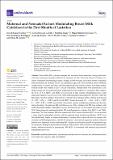Por favor, use este identificador para citar o enlazar a este item:
http://hdl.handle.net/10261/334103COMPARTIR / EXPORTAR:
 SHARE SHARE
 CORE
BASE CORE
BASE
|
|
| Visualizar otros formatos: MARC | Dublin Core | RDF | ORE | MODS | METS | DIDL | DATACITE | |

| Título: | Maternal and neonatal factors modulating breast milk cytokines in the first month of lactation |
Autor: | Ramiro-Cortijo, David; Herranz Carrillo, Gloria; Singh, Pratibha; Rebollo-Hernanz, Miguel CSIC ORCID ; Rodríguez-Rodríguez, Pilar; Ruvira, Santiago; Martín-Trueba, María CSIC; Martin, Camilia R.; Arribas, Silvia M. | Palabras clave: | Cytokines Breast milk Neonatal adverse outcome Sex Inflammatory diet Total antioxidant capacity Prematurity Lipid peroxidation |
Fecha de publicación: | 2023 | Editor: | Multidisciplinary Digital Publishing Institute | Citación: | Antioxidants 12(5): 996 (2023) | Resumen: | Breast milk (BM) cytokines support and modulate infant immunity, being particularly relevant in premature neonates with adverse outcomes (NAO). This study aimed to examine, in a cohort of Spanish breastfeeding women, changes in BM cytokines in the first month of lactation, their modulation by neonatal factors (sex, gestational age, and NAO), maternal factors (obstetric complications, C-section, and diet), and their relationship with oxidative status. Sixty-three mother-neonate dyads were studied at days 7 and 28 of lactation. Dietary habits were assessed by a 72-h dietary recall, and the maternal dietary inflammatory index (mDII) was calculated. BM cytokines (IL-10, IL-13, IL-8, MCP-1, and TNFα) were assessed by ultra-sensitive chemiluminescence. Total antioxidant capacity was assessed by the ABTS method and lipid peroxidation by the MDA+HNE kit. From days 7 to 28 of lactation, the levels of IL-10 and TNFα remained stable, while IL-13 increased (β = 0.85 ± 0.12, p < 0.001) and IL-8 and MCP-1 levels decreased (β = −0.64 ± 0.27, p = 0.019; β = −0.98 ± 0.22, p < 0.001; respectively). Antioxidant capacity and lipid peroxidation also decrease during lactation. Neonatal sex did not influence any of the cytokines, but BM from mothers with male infants had a higher antioxidant capacity. Gestational age was associated with male sex and NAO, being inversely correlated with the BM proinflammatory cytokines IL-8, MCP-1, and TNFα. From days 7 to 28 of lactation, BM from women with NAO infants increased MCP-1 levels and had a larger drop in antioxidant capacity, with the opposite trend in lipid peroxidation. MCP-1 was also significantly higher in women undergoing C-section; this cytokine declined in women who decreased mDII during lactation, while IL-10 increased. Linear mixed regression models evidenced that the most important factors modulating BM cytokines were lactation period and gestational age. In conclusion, during the first month of lactation, BM cytokines shift towards an anti-inflammatory profile, influenced mainly by prematurity. BM MCP-1 is associated with maternal and neonatal inflammatory processes. | Descripción: | This article belongs to the Special Issue Role of Oxidative Stress and Inflammation in Maternal-Perinatal Well-Being. | Versión del editor: | https://doi.org/10.3390/antiox12050996 | URI: | http://hdl.handle.net/10261/334103 | DOI: | 10.3390/antiox12050996 | E-ISSN: | 2076-3921 |
| Aparece en las colecciones: | (CIAL) Artículos |
Ficheros en este ítem:
| Fichero | Descripción | Tamaño | Formato | |
|---|---|---|---|---|
| maternalactation.pdf | 1,69 MB | Adobe PDF |  Visualizar/Abrir |
CORE Recommender
PubMed Central
Citations
3
checked on 03-may-2024
SCOPUSTM
Citations
4
checked on 09-may-2024
WEB OF SCIENCETM
Citations
4
checked on 23-feb-2024
Page view(s)
38
checked on 10-may-2024
Download(s)
20
checked on 10-may-2024

